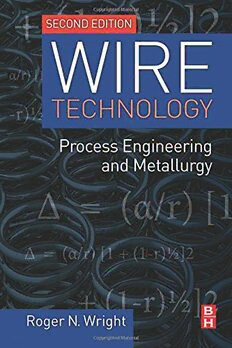Table Of ContentWIRE
TECHNOLOGY
WIRE
TECHNOLOGY
Process Engineering and
Metallurgy
Second Edition
By
ROGER N. WRIGHT
AMSTERDAM (cid:129) BOSTON (cid:129) HEIDELBERG (cid:129) LONDON
NEW YORK (cid:129) OXFORD (cid:129) PARIS (cid:129) SAN DIEGO
SAN FRANCISCO (cid:129) SINGAPORE (cid:129) SYDNEY (cid:129) TOKYO
Butterworth-Heinemann is an imprint of Elsevier
ButterworthHeinemannisanimprintofElsevier
TheBoulevard,LangfordLane,Kidlington,OxfordOX51GB,UK
50HampshireStreet,5thFloor,Cambridge,MA02139,USA
Copyright©2016,2011ElsevierInc.Allrightsreserved.
Nopartofthispublicationmaybereproducedortransmittedinanyformorbyany
means,electronicormechanical,includingphotocopying,recording,oranyinformation
storageandretrievalsystem,withoutpermissioninwritingfromthepublisher.Detailson
howtoseekpermission,furtherinformationaboutthePublisher’spermissionspolicies
andourarrangementswithorganizationssuchastheCopyrightClearanceCenterand
theCopyrightLicensingAgency,canbefoundatourwebsite:www.elsevier.com/
permissions.
Thisbookandtheindividualcontributionscontainedinitareprotectedundercopyright
bythePublisher(otherthanasmaybenotedherein).
Notices
Knowledgeandbestpracticeinthisfieldareconstantlychanging.Asnewresearchand
experiencebroadenourunderstanding,changesinresearchmethods,professional
practices,ormedicaltreatmentmaybecomenecessary.
Practitionersandresearchersmustalwaysrelyontheirownexperienceandknowledge
inevaluatingandusinganyinformation,methods,compounds,orexperimentsdescribed
herein.Inusingsuchinformationormethodstheyshouldbemindfuloftheirownsafety
andthesafetyofothers,includingpartiesforwhomtheyhaveaprofessionalresponsibility.
Tothefullestextentofthelaw,neitherthePublishernortheauthors,contributors,
oreditors,assumeanyliabilityforanyinjuryand/ordamagetopersonsorproperty
asamatterofproductsliability,negligenceorotherwise,orfromanyuseoroperation
ofanymethods,products,instructions,orideascontainedinthematerialherein.
LibraryofCongressCataloging-in-PublicationData
AcatalogrecordforthisbookisavailablefromtheLibraryofCongress
BritishLibraryCataloguinginPublicationData
AcataloguerecordforthisbookisavailablefromtheBritishLibrary
ISBN:978-0-12-802650-2
ForinformationonallButterworthHeinemannpublications
visitourwebsiteathttp://store.elsevier.com/
DEDICATION
Tomywife,Patricia,whohaslearnedthateveryroomisanoffice,andevery
table a desk.
v
PREFACE
Being in a family with several generations of professional practitioners in
metals processing and the teaching thereof, I suppose my writing of this
bookwasinevitable.Evenso,Imustclearlyacknowledgetwostronginflu-
encesoutsideofthefamilysphere.ThefirstwasthelateWalterA.(Al)Back-
ofen,professorofmetallurgyandmaterialsscienceatMITahalfcenturyor
soago.WhileIreceivedthebenefitofsomeofhislectures,hismajorimpact
was by the way of his book Deformation Processing, Addison-Wesley, 1972.
This book was the first that I am aware of to teach deformation processing
withmajoremphasisonΔ,theshapeofthedeformationzone.Tobesure,Δ
oritsequivalentwasutilizedinsomeofthemoreenlightenedmid-twentieth
centurywiredrawingresearch(mostnotablythatofJ.G.Wistreich)andcita-
tionsoftheimportanceofdeformationzonegeometrycanbefoundinthe
literature of the 1920s. However, Backofen powerfully employed it as a
teachingtool,bringingtogetheraconsiderablearrayofmechanicalanalyses,
processdesigns,andmechanicalmetallurgicalphenomenology.Asayoung
metallurgist, I assumed that just about everybody used Δ, only to find out
thatitswork-a-dayindustrialapplicationshadbeenminimal.Inthiscontext,
Iappliedit(arguablyevenoverappliedit)everychancethatIhad,andinthe
wireindustryIbelieveithasbeenofsignificantvalue.Inanycase,itiscentral
to much of this book, and I have Professor Backofen to thank.
TheotherinfluencethatIwouldliketocitewasDr.AlanT.Male,my
managerduringtheyearsthatIspentatWestinghouseResearchLaborato-
ries.Alanwas,ofcourse,renownforhisdevelopmentoftheringcompres-
sion test that quantifies friction in forging (a brilliant application of
deformationzonegeometry,incidentally).Moreover,hehadbeenafaculty
member at The University of Birmingham and had an instinctive and syn-
ergisticapproachtoapplyingrigorousresearchtechniqueandperspectiveto
industrial processing systems. He, early on, directed my involvement in a
widevarietyofsophisticatedwireprocessingstudies,aswellasinthesuper-
visionofindustrialsocietyseminarsandshortcourses.WhenIleftWesting-
house to join the faculty at Rensselaer Polytechnic Institute in 1974, I had
beengivenathorougheducationinwireprocessing,togowithmybroader
backgrounds in metallurgy and metals processing.
Addressingthesubjectathand,Ihavewrittenthisbookinthestyleofan
upper-level undergraduate, or possibly graduate-level text, acknowledging
xiii
xiv Preface
thatoneisnotlikelytofindsuchacourseonwireprocessing,exceptperhaps
inEasternEurope.Thisapproachhasallowedmetousedirectlymuchofmy
experienceintechnology-focusedshortcourses,aswellasmyexperiencein
teachingundergraduatesandgraduatestudentsatRensselaer.Ihavewritten
itwiththehopethatitwillbeusefulforself-studyandcontinuingeducation
offerings,aswellasservingasadeskreference.Atthispointintime,Ibelieve
that it occupies a unique position in the engineering literature.
Thissecondeditiondiffersfromitspredecessorprimarilyinitssummary
and citation of relevant research of the 2009-2015 time frame.
Finally,IwouldliketothankthemosthelpfulstaffatElsevierInc.,par-
ticularlyJeffreyFreeland,fortheirpatienthandlingofthissecondeditionof
my book.
Roger N. Wright, ScD, PE, FASM, FSME
ABOUT THE AUTHOR
RogerN.Wright,professoremeritus,School
of Engineering, Rensselaer Polytechnic
Institute,hascontributedbroadlytotheliter-
ature in the areas of metallurgy and metals
processing and is active as a short-course
lecturer and consultant. Prior to joining
Rensselaer, he was a senior staff member at
Westinghouse Research Laboratories and at
Allegheny Ludlum Steel Corporation. He
holds B.S. and Sc.D. degrees in metallurgy
fromMassachusettsInstituteofTechnology.
Heisaregisteredprofessionalengineeranda
fellowofASMInternationalandoftheSocietyofManufacturingEngineers.
xv
CHAPTER 1
The General Idea
Contents
1.1 Concepts 1
1.1.1 Drawing 1
1.1.2 Wire,Rod,andBar 1
1.1.3 Materials 2
1.2 HowDoesDrawingWork? 2
1.2.1 WhyNotSimplyStretchtheWire,Rod,orBar? 2
1.2.2 ASimpleExplanationoftheDrawingProcess 3
1.2.3 ComparisontoOtherProcesses 4
1.2.4 OverallProcessHardware 5
1.3 QuestionsandProblems 6
1.1 CONCEPTS
1.1.1 Drawing
Theconceptofdrawingaddressedinthisbookinvolvespullingwire,rod,or
barthroughadieorconvergingchanneltodecreasecross-sectionalareaand
increaselength.Inthemajorityofcases,thecrosssectioniscircular,although
noncircular cross sections may be drawn and/or created by drawing. In
comparison to rolling, drawing offers much better dimensional control,
lowercapitalequipmentcost,andextensiontosmallcrosssections.Incom-
parison to extrusion, drawing offers continuous processing, lower capital
equipment cost, and extension to small cross sections.
1.1.2 Wire, Rod, and Bar
Ingeneral,theanalysesofwire,rod,andbardrawingaresimilar,andwemay
usethetermworkpiece,orsimplytheterm“wire,”whenthereisnodis-
tinction to be drawn. However, there are major practical and commercial
issuestobeaddressedamongtheseterms.Bardrawingusuallyinvolvesstock
that is too large in cross section to be coiled and hence must be drawn
straight.Roundbarstockmaybe1-10cmindiameterorevenlarger.Prior
WireTechnology Copyright©2016ElsevierInc.
http://dx.doi.org/10.1016/B978-0-12-802650-2.00001-7 Allrightsreserved. 1
2 WireTechnology
todrawing,barstockmayhavebeencast,rolled,extruded,orswaged(rotary
cold forged). Rod drawing involves stock that may be coiled, and hence
may be delivered to the die from a coil, and taken up as a coil, on a block
or capstan. Round rod stock will often have a 0.3-1-cm diameter and will
oftenhavebeencastand/orrolledpriortodrawing.Wiredrawinginvolves
stockthatcanbeeasilycoiledandsubjectedtosequentialortandemdrawing
operations with as many as a dozen or more draws occurring with a given
drawing machine. Each drawing operation or “pass” will involve delivery
of the wire to the die from a coil on a capstan, passage through the die,
and take-up on a capstan that pulls the wire through the die. Fine wire
drawing typically refers to round wire with a diameter of less than
0.1mm,andultra-finewiredrawingtypicallyreferstoroundwireasfine
as 0.01mm in diameter.
1.1.3 Materials
Essentiallyanyreasonablydeformablematerialcanbedrawn,andthegeneral
analysisisthesameregardlessofthewire,rod,orbarmaterial.Theindividual
technologies for the major commercial materials, however, involve many
nuances. The drawing technologies are often divided into ferrous (steel)
and nonferrous and electrical (usually copper and aluminum), although
thereisspecialtyproductionandresearchanddevelopmentinterestinsuch
high-value-addedproductsasthermocouplewire,preciousmetalwire,bio-
medicalwire,wireforhightemperatureservice,superconductingwire,and
so on.
Apart from the material drawn, drawing technology depends substan-
tially on the materials used for dies (“carbide,” diamond, tool steel) and
on the materials or formulations used for lubricants and coatings.
1.2 HOW DOES DRAWING WORK?
1.2.1 Why Not Simply Stretch the Wire, Rod, or Bar?
Itcanbeargued,atleastinprinciple,thatsomeoftheobjectivesofdrawing
couldbeachievedbysimplystretchingthewirewithapullingforce.The
crosssectioncouldbereducedandelongationaccomplished,butdieswould
not be needed and the friction and metal flow issues presented by the die
could be avoided.
Theprincipalproblemwithjuststretchingthewirewithapullingforceis
the necking phenomenon. Basically, after a certain amount of uniform
TheGeneralIdea 3
stretching, all further elongation will be concentrated at a single location
(aneck),whichwillrapidlythinandbreak.Thisoccursbecausethedecrease
incross-sectionalareaeventuallyweakensthewiremorethananystrength-
eningthatoccursbyworkhardening.Heavilydrawnwirewillhavelittleor
no work-hardening capability and will neck almost at once if subjected to
simple stretching. Although some complex “dieless” drawing systems have
been invented, simple stretching has only limited application becauseof its
vulnerability to necking.
1.2.2 A Simple Explanation of the Drawing Process
Inthedrawingprocess,apullingforceandapressureforce,fromthedie,
combine to cause the wire to extend and reduce in cross-sectional area,
while passing through the die, as schematically illustrated in Figure 1.1.
Because of this combined effect, the pulling force or drawing force can
belessthantheforcethatwouldcausethewiretostretch,neck,andbreak
downstream from the die. On the other hand, if a reduction too large in
cross-sectional area is attempted at the die, the drawing force may break
thewire.Incommercialpractice,engineeredpullingloadsarerarelyabove
60%oftheas-drawnstrength,andtheareareductioninasingledrawingpass
israrelyabove30%or35%andisoftenmuchlower.Aparticularlycommon
reduction in nonferrous drawing is the American Wire Gage (AWG)
number or about 20.7%. Many drawing passes are needed to achieve large
overall reductions.
Figure1.1 Schematicillustrationofforcesindrawing.

